Study on Micro-Displacement Mechanism and Reservoir Compatibility of Soft Dispersed Microgel
Abstract
1. Introduction
2. Results and Discussions
2.1. Swelling Property of SMG
2.2. Rheological Property of SMG Aqueous Dispersion
2.3. Micro-Scale Experiment of SMG
2.4. Analysis of Experimental Results of the Matching Relationship between SMG Particles and Reservoirs
3. Conclusions
4. Materials and Methods
4.1. Preparation of Materials
4.2. Experimental Setups
4.3. Methods
4.3.1. Measurement of SMG Particle Size and Rheological Property
4.3.2. Microinjection Experiment
4.3.3. Experiment on the Matching Relationship between SMG Particle and Reservoir
Author Contributions
Funding
Institutional Review Board Statement
Informed Consent Statement
Data Availability Statement
Acknowledgments
Conflicts of Interest
References
- He, L.; Hanbing, X. Deep Fluid Diversion for Profile Control and Oil Displacement Technologies. In Proceedings of the International Petroleum Technology Conference, Bangkok, Thailand, 15–17 November 2011; p. 14217. [Google Scholar]
- Xiangguo, L.; Bao, C.; Kun, X.; Weijia, C.; Yigang, L.; Yunbao, Z.; Xiaoyan, W.; Jie, Z. EOR mechanisms of polymer flooding in a heterogeneous oil reservoir. Pet. Explor. Dev. 2021, 48, 148–155. [Google Scholar]
- Cancan, Z.; Yongjun, W.; Fengming, Z. Modeling and application of the lithofacies controlled primary pore reservoir of proximal sandstone. Pet. Explor. Dev. 2006, 33, 553–557. [Google Scholar]
- Qitai, Q. Three major rich areas of “large scale” unswept remaining oil in water flooded beded sandstone resrvoirs. Acta Pet. Sin. 2000, 21, 45–50. [Google Scholar]
- Yang, S.; Yunfei, X.; Zhihua, W. An Experimental Study on Efficient Demulsification for Produced Emulsion in Alkaline/Surfactant/Polymer Flooding. J. Energy Resour. Technol.-Trans. Asme 2022, 144, 093001. [Google Scholar] [CrossRef]
- Juarez-Morejon, J.L.; Bertin, H.; Omari, A.; Hamon, G.; Cottin, C.; Morel, D.; Romero, C.; Bourdarot, G. A New Approach to Polymer Flooding: Effects of Early Polymer Injection and Wettability on Final Oil Recovery. SPE J. 2019, 24, 129–139. [Google Scholar] [CrossRef]
- Delamaide, E. Polymer Flooding of Heavy Oil-Form Screening to Full-Field Extension. In Proceedings of the SPE Heavy and Extra Heavy Oil Conference: Latin America, Medellín, Colombia, 24–26 September 2014; p. 171105. [Google Scholar]
- Afeez, G.; Shirish, P.; Shahzad, K.M.; Adewunmi, A.A.; Yusuff, A.S.; Agi, A.; Oseh, J. Application of Polymers for Chemical Enhanced Oil Recovery: A Review. Polymers 2022, 14, 1433. [Google Scholar] [CrossRef]
- Darbi, A.M.; Ling, P.A.; Agus, A.; Junin, R.; Syariefudin, M.I.; Regina, S.; Husna, U.Z.; Ahmadipour, M. A Short Review of Biopolymers for Enhanced of Oil Recovery in Mature Fields. Pet. Chem. 2022, 62, 482–498. [Google Scholar] [CrossRef]
- Chenzhi, Y. Chemical Flooding to Enhance Oil Recovery; Petroleum Industry Press: Beijing, China, 1999; pp. 40–56. [Google Scholar]
- Masalmeh, S.K.; Wei, L.; Blom, C.; Jing, X.D. EOR Options for Heterogeneous Carbonate Reservoirs Currently Under Waterflooding. In Proceedings of the Abu Dhabi International Petroleum Exhibition and Conference, Abu Dhabi, United Arab Emirates, 10–13 November 2014; p. 171900. [Google Scholar]
- Shuyun, W.; Yanming, B.; Jie, S.; Zhaohui, Y. Polymer-injection response of tertiary infilling producers in the west-central area, Daqing Oilfield. Pet. Explor. Dev. 2004, 31, 123–125. [Google Scholar]
- Dongmei, W.; Huanzhong, D.; Changsen, L.; Fu, X.; Nie, J. Review of Practical Experience of Polymer Flooding at Daqing. SPE Reserv. Eval. Eng. 2009, 12, 114342. [Google Scholar]
- Prasad, D.; Pandey, A.; Kumar, M.S.; Koduru, N. Pilot to Full-field Polymer Application in One of the Largest Onshore Field in India. In Proceedings of the SPE Improved Oil Recovery Symposium, Tulsa, OK, USA, 12–16 April 2014; p. SPE-169146-MS. [Google Scholar]
- Leon, J.M.; Castillo, A.; Perez, R.; Jimenez, J.A.; Izadi, M.; Mendez, A.; Castillo, O.P.; Londoño, F.W.; Zapata, J.F.; Chaparro, C.H. A Successful Polymer Flood Pilot at Palogrande-Cebu, A Low Permeability Reservoir in the Upper Magdalena Valley, Colombia. In Proceedings of the SPE Improved Oil Recovery Conference, Tulsa, OK, USA, 14–18 April 2018; p. 190165. [Google Scholar]
- Li, B.; Zhang, J.; Kang, X.; Zhang, F.; Wang, S.; Zhao, W.; Wang, X.; Wei, Z. Review and Prospect of the Development and Field Application of China Offshore Chemical EOR Technology. In Proceedings of the Abu Dhabi International Petroleum Exhibition & Conference, Abu Dhabi, United Arab Emirates, 11–14 November 2019; p. 197181. [Google Scholar]
- Abhijit, K.; Achinta, B.; Ahmed, A.-Y. A review on advanced nanoparticle-induced polymer flooding for enhanced oil recovery. Chem. Eng. Sci. 2022, 626, 117994. [Google Scholar] [CrossRef]
- Zulhelmi, A.; Mohd, S.I.; Mohamed, J.B.; Patah, M.F.A.; Khalil, M.; Bakar, W.Z.W. PAM/PEI polymer gel for water control in high-temperature and high-pressure conditions: Core flooding with crossflow effect. Korean J. Chem. Eng. 2022, 39, 605–615. [Google Scholar] [CrossRef]
- Kaoping, S.; Jianwen, T.; Xiuqin, L.; Yang, X.; Shaopeng, L.; Zhengbo, W.; Huifeng, L.; Yuxuan, Z.; Hongtao, F.; En, M.; et al. Recent Advances in Polymer Flooding in China. Molecules 2022, 27, 6978. [Google Scholar] [CrossRef]
- Chen, S.; Hu, G.; Yiqiang, L.; Song, K. Recent Advances of Surfactant-Polymer (SP) Flooding Enhanced Oil Recovery Field Tests in China. Geofluids 2020, 2020, 8286706. [Google Scholar] [CrossRef]
- Kumar, S.V.; Anugrah, S.; Pankaj, T. An experimental study of pore-scale flow dynamics and heavy oil recovery using low saline water and chemical flooding. Fuel 2022, 334, 126756. [Google Scholar] [CrossRef]
- Rosado-Vazquez, F.J.; Bashbush-Bauza, J.L.; López-Ramírez, S. Practical Mathematical Model for the Evaluation of Main Parameters in Polymer Flooding: Rheology, Adsorption, Permeability Reduction, and Effective Salinity. ACS Omega 2022, 7, 24982–25002. [Google Scholar] [CrossRef]
- Ehsan, A.; Sajjad, E.; Soheil, S.; Maini, B.; Sundararaj, U.; Chen, Z. New insight to polymer transport in porous media to enhance heavy oil recovery: Lab experiment and numerical simulation. Fuel 2022, 322, 124257. [Google Scholar] [CrossRef]
- Xingcai, W.; Chunming, X.; Dakuang, H.; Liu, H.; Gao, S.; Xu, H.; Dong, F.; Ren, F. A New IOR Method for Mature Waterflooding Reservoirs: Sweep Control Technology. In Proceedings of the SPE Asia Pacific Oil & Gas Conference and Exhibition, Adelaide, Australia, 14–16 October 2014; p. 171485. [Google Scholar]
- Xingcai, W.; Dakuang, H.; Xiangguo, L.; Ye, Y.Z.; Su, Z. Oil Displacing Mechanism of Soft Microgel Particle Dispersion in Porous Media. Earth Sci. 2017, 42, 1348–1355. [Google Scholar]
- Yang, L.; Xingcai, W.; Baoshan, G.; Yingzhu, Y.; Hanbing, X.; Xiaocong, W.; Shichao, L.; Peiwen, X. Experiment on water-flooding sweep control technique for carbonate reservoir with abnormally high temperature and high salinity: A case study of Abu Dhabi X Oilfield. Pet. Geol. Recovery Effic. 2021, 28, 72–79. [Google Scholar]
- Yang, L.; Jian, Z.; Xingcai, W.; Kang, X.; Guan, B.; Li, X.; Ye, Y.; Xiao, P.; Wang, X.; Li, S. Experiment Investigation on a Novel Particle Polymer for Enhanced Oil Recovery in High Temperature and High Salinity Reservoirs. J. Chem. 2021, 2021, 5593038. [Google Scholar]
- Wu, X.; Song, S.; Xiong, C.; Guo, Z.; Xu, H.; Jiang, P.; Zhang, J.; Zhang, Y.; Chen, J.; Tian, X.; et al. A New Polymer Flooding Technology for Improving Heavy Oil Reservoir Recovery-from Lab Study to Field Application—Case Study of High Temperature Heavy Oil Field Z70. In Proceedings of the SPE Canada Heavy Oil Technical Conference, Calgary, AB, Canada, 7–9 June 2015; p. 1714511. [Google Scholar]
- Xingcai, W.; Qingchun, M.; Chunming, X.; Xu, H.; Sun, Z.; Liu, Y.; Lu, X.; Cheng, S.; Jia, X.; Tian, X. An Innovative EOR Theory For the Target of 70% Recovery Factor—Synchronous Diversion-flooding Technology Mechanism and Verification by Physical Modeling and Pilot Test. In Proceedings of the International Petroleum Technology Conference, Bangkok, Thailand, 14–16 November 2016; p. 18642. [Google Scholar]
- Xingcai, W.; Weiyu, C.; Chunming, X.; Huang, B.; Meng, H.; Wu, Q.; Ma, C.; Xu, H.; Ye, Y. Successful Sweeping Control Technology Test for Offshore Heavy Oilfield—Case Study of QHD32 Reservoir in Bohai Bay. In Proceedings of the Offshore Technology Conference, Houston, TX, USA, 2–5 May 2016; p. 27107. [Google Scholar]
- Xingcai, W.; Hongbiao, W.; Zhongyu, B.; Bai, L.; Zhang, S.; Yu, Z.; Xu, H.; Zeng, Q.; Jiang, Y. An Innovative EOR Method For Waterflooding Heterogeneous Oilfield—Graded Diversion-flooding Technology and Verification by Field Comparison Tests. In Proceedings of the SPE Russian Petroleum Technology Conference, Moscow, Russia, 16–18 October 2017; p. 187845. [Google Scholar]
- Yang, L.; Yinzhu, Y.; Xingcai, W.; Hanbing, X.; Shichao, L. Swept control technique (SCT) for the deep profile-control and flooding of high-temperature high-salinity carbonate oil reservoirs: A case study on Oman B4 reservoir in the Middle East. Pet. Geol. Oilfield Dev. Daqing 2021, 40, 79–86. [Google Scholar]
- Xingcai, W.; Debin, Q.; Hanbing, X.; Li, J.; Xiong, C.; Liang, W.; Wang, L.; Xiong, Y.; Wu, Q.; Yu, Z.; et al. The Economic Analysis and Application Strategies of EOR Technology in Low-Oil-Price Period—8 Case Study of a New Polymerflooding Technology. In Proceedings of the SPE Annual Technical Conference and Exhibition, Dubai, UAE, 26–28 September 2016; p. 182145. [Google Scholar]
- Caili, D.; Chenwei, Z.; Yifei, L.; Ying, T.; Chuan, W.; Chaohui, S. Matching principle and in-depth profile control mechanism between elastic dispersed particle gel and pore throat. Acta Pet. Sin. 2018, 39, 427–434. [Google Scholar]
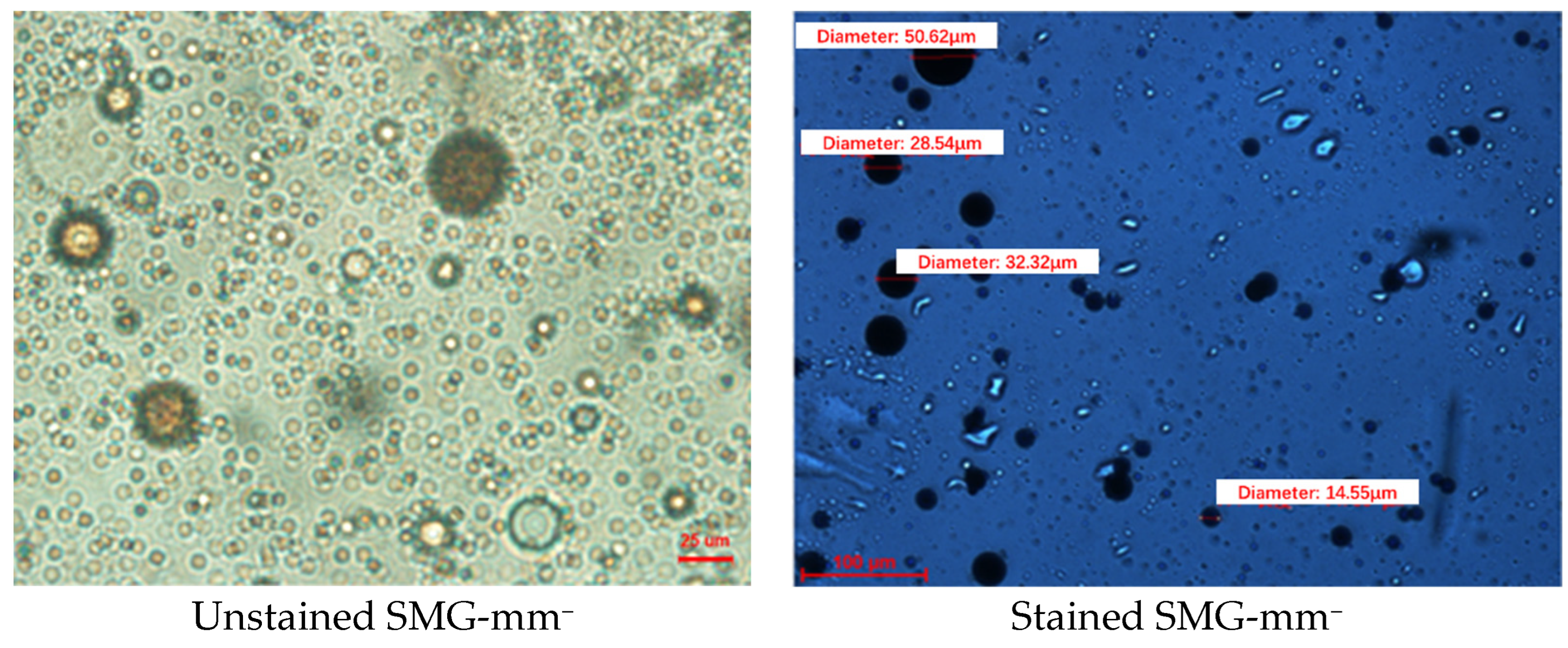
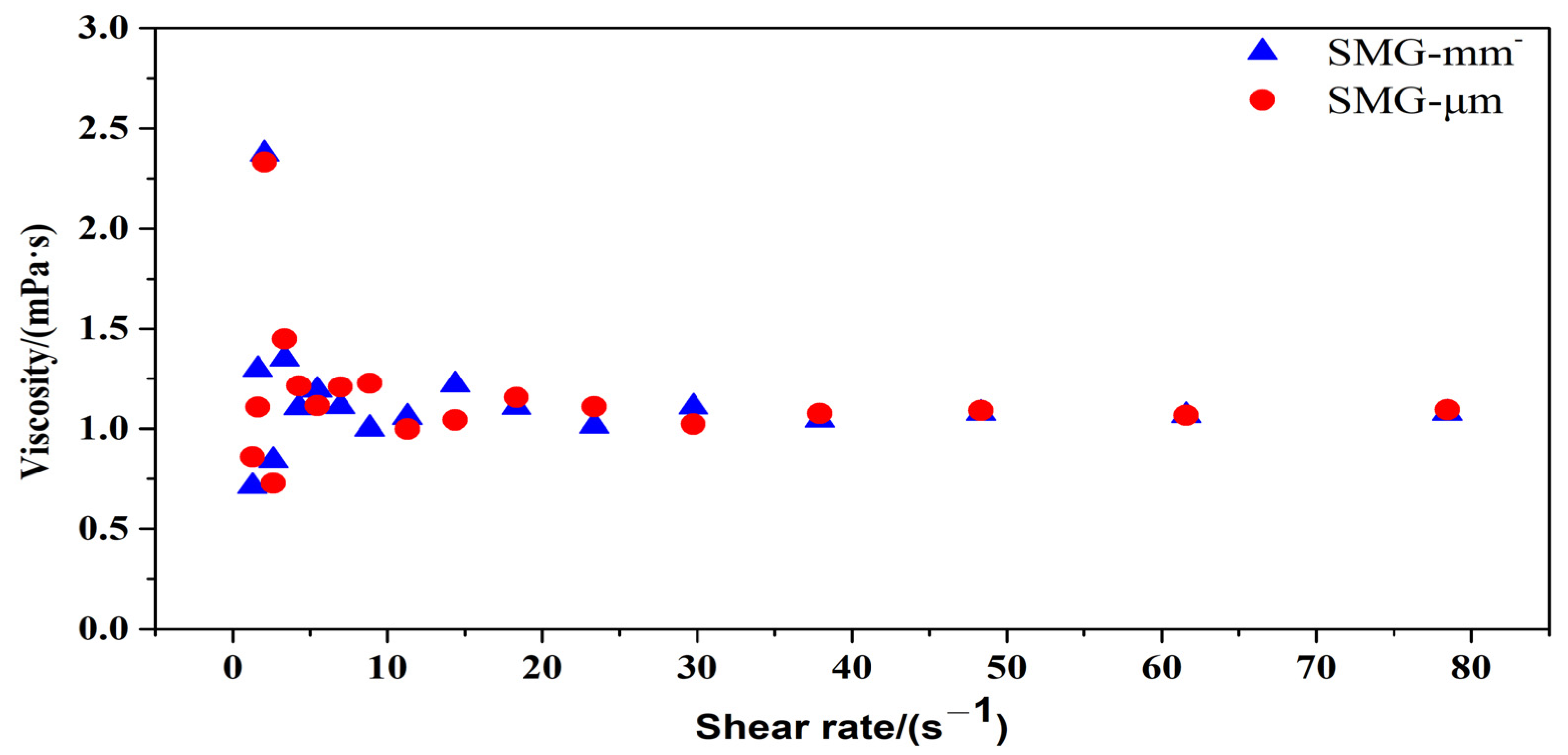

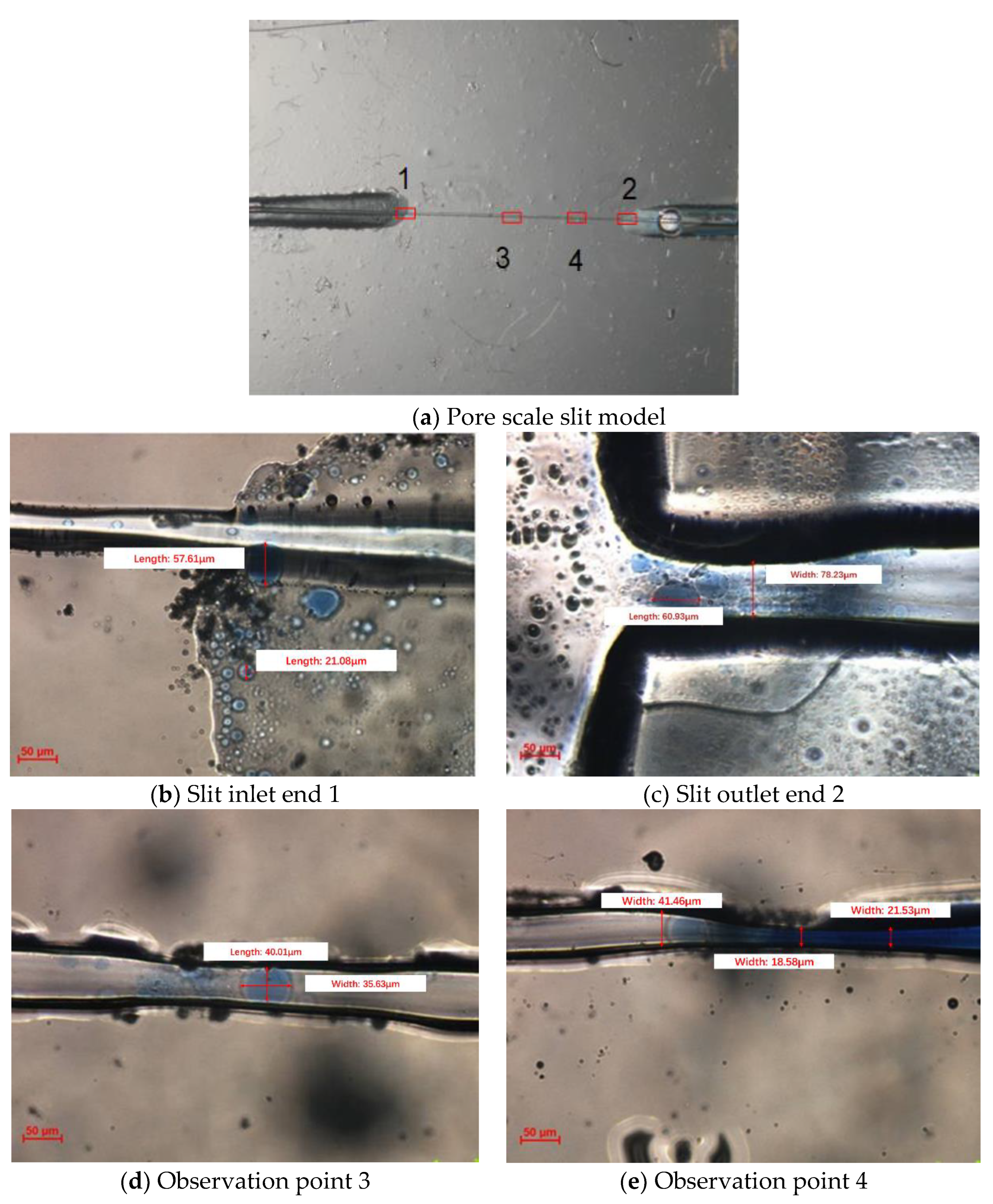

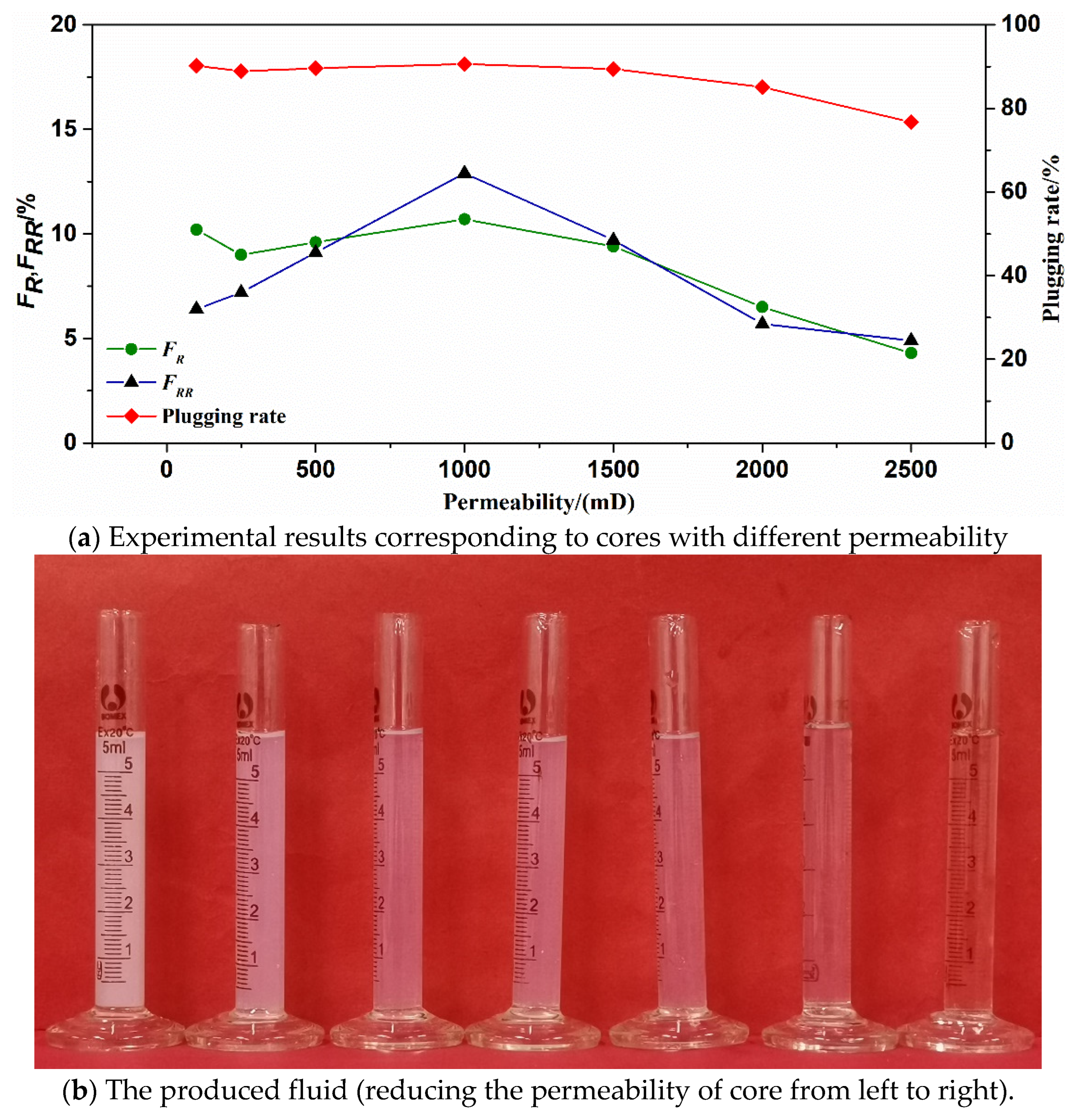
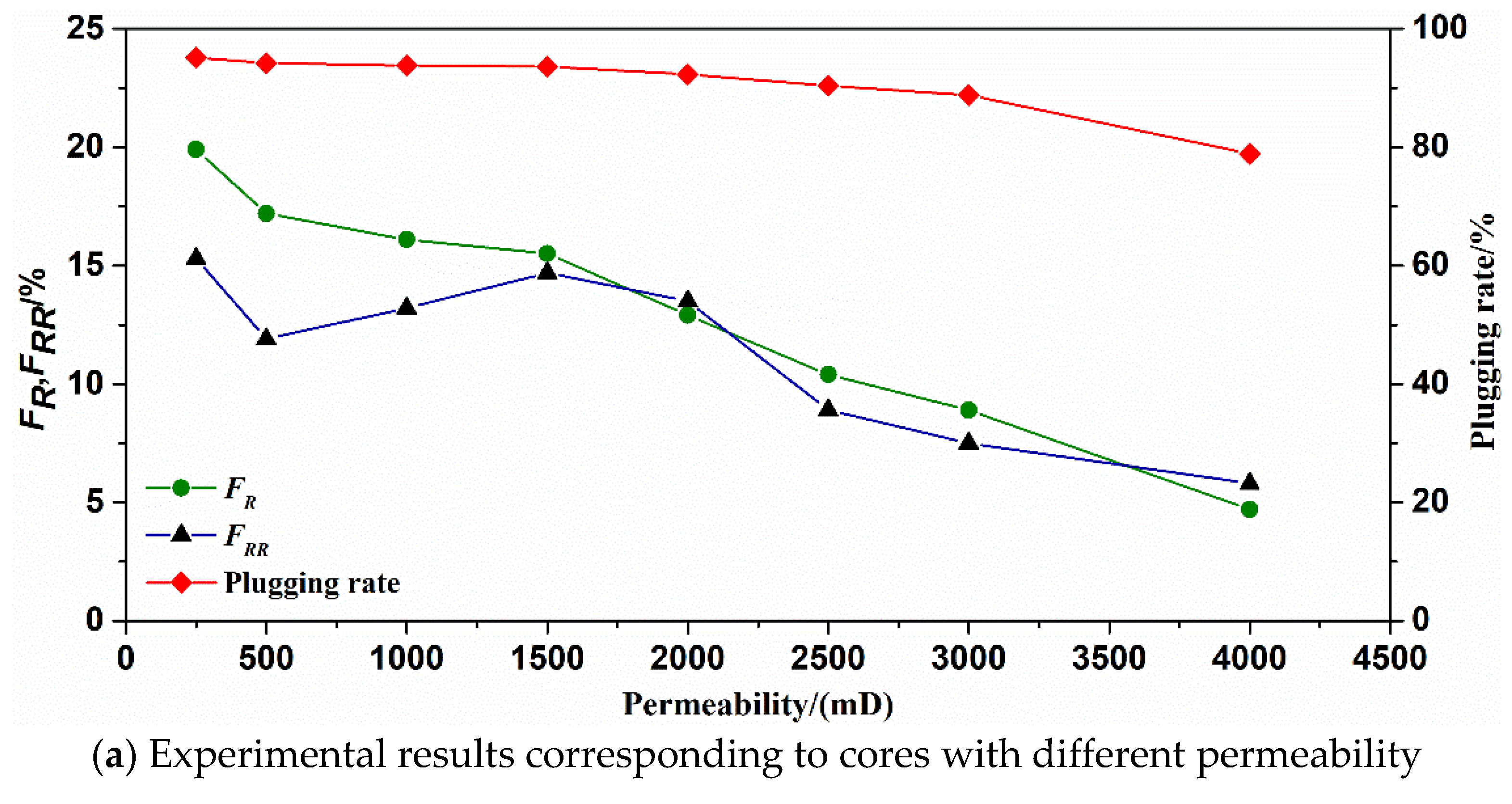
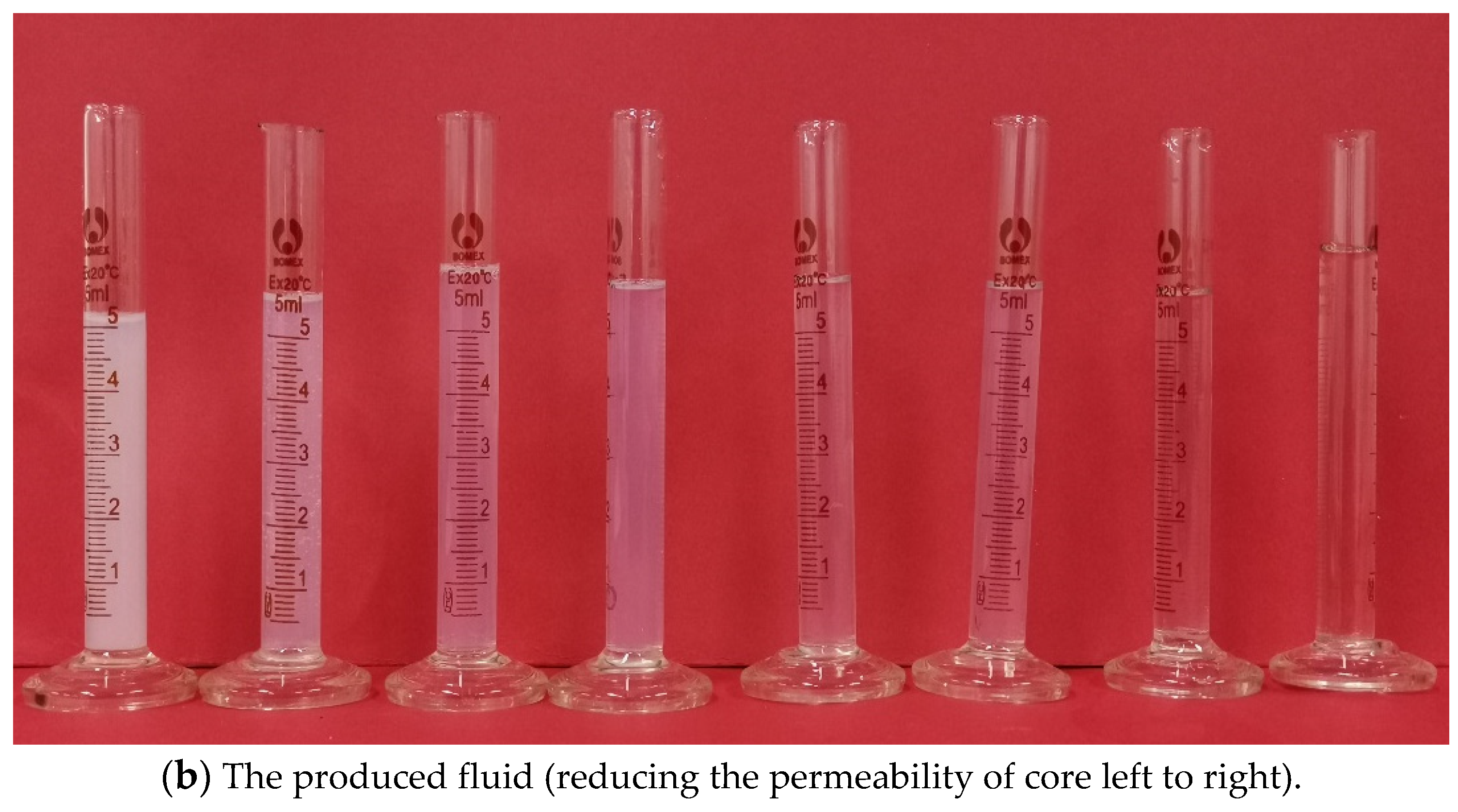
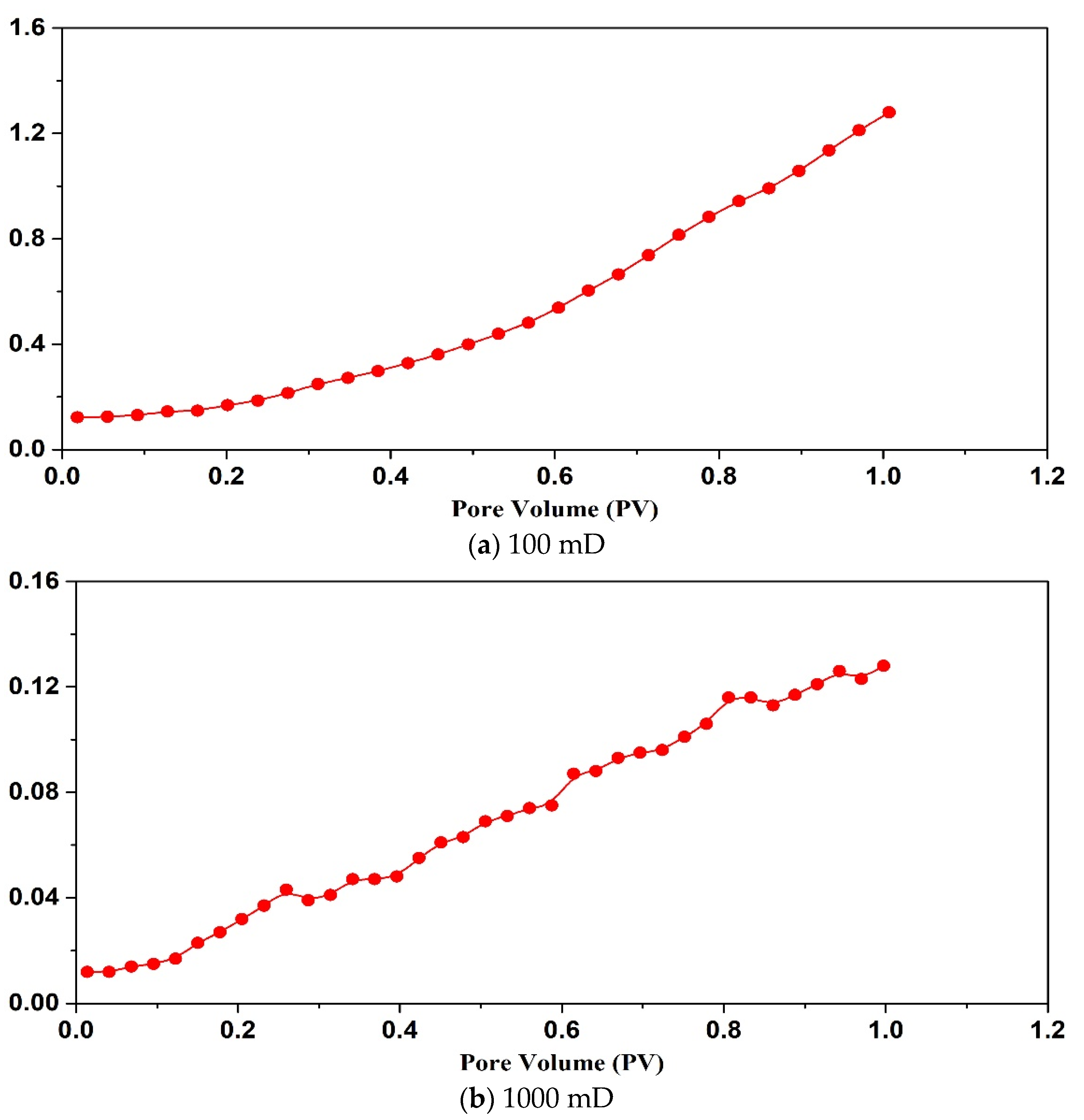
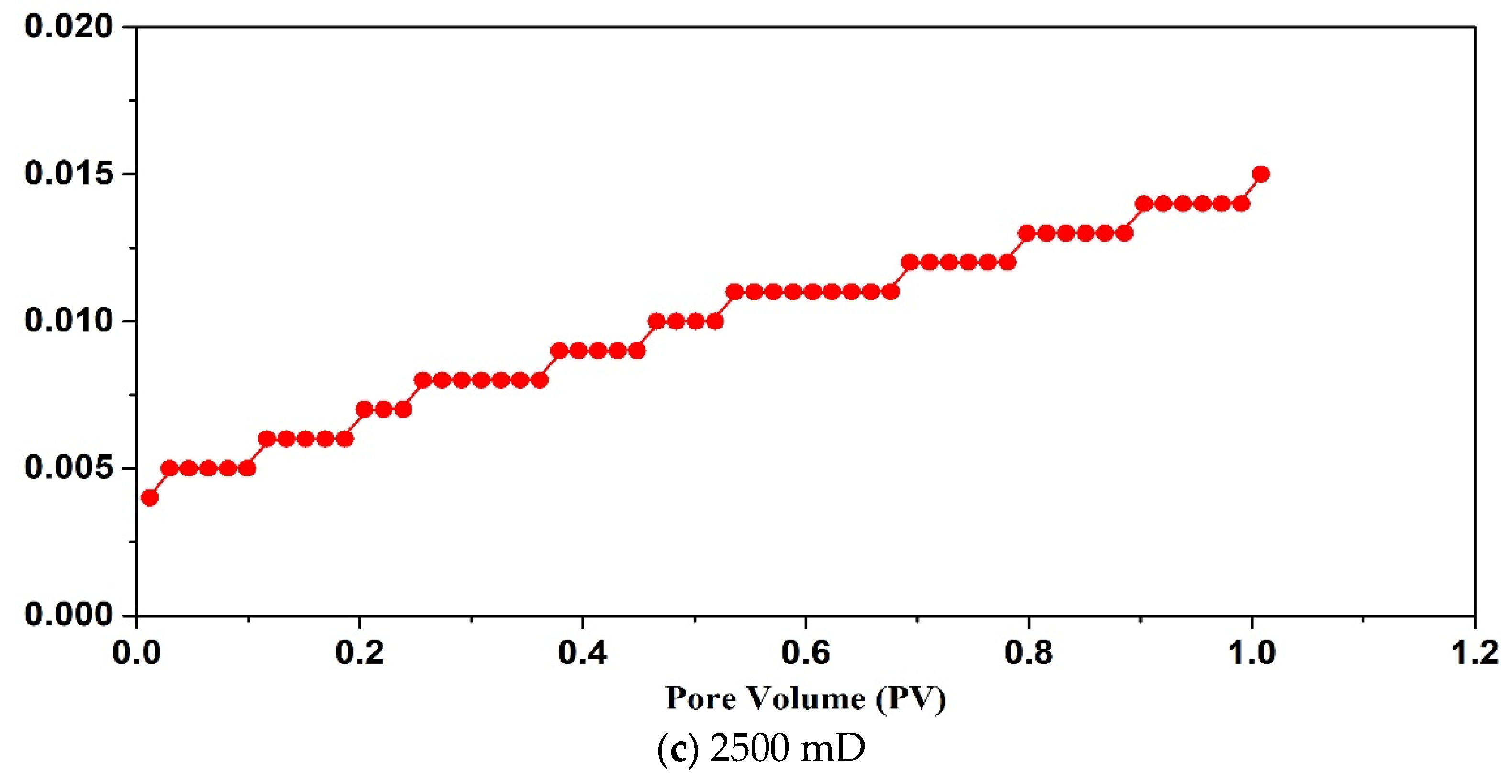

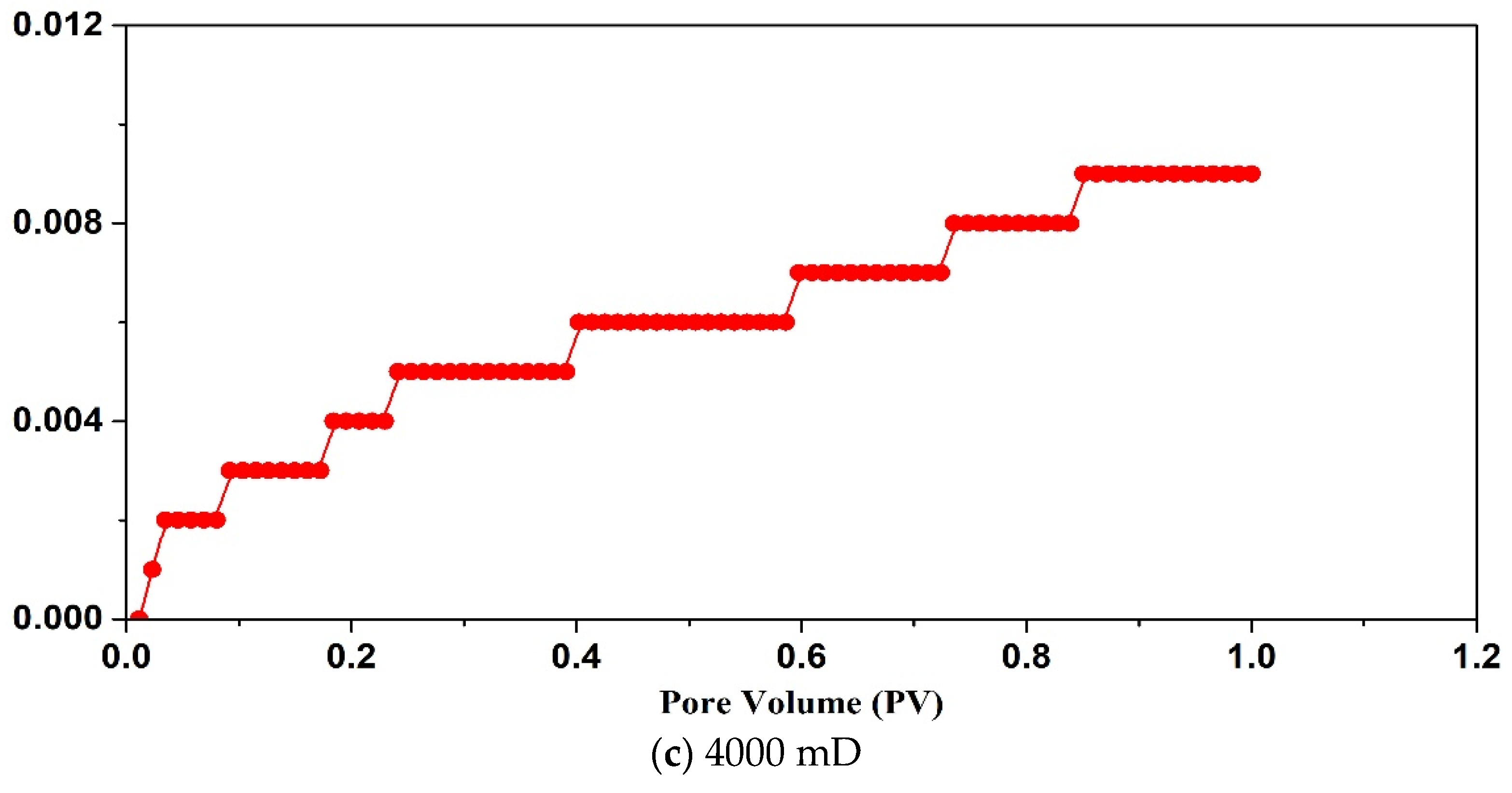

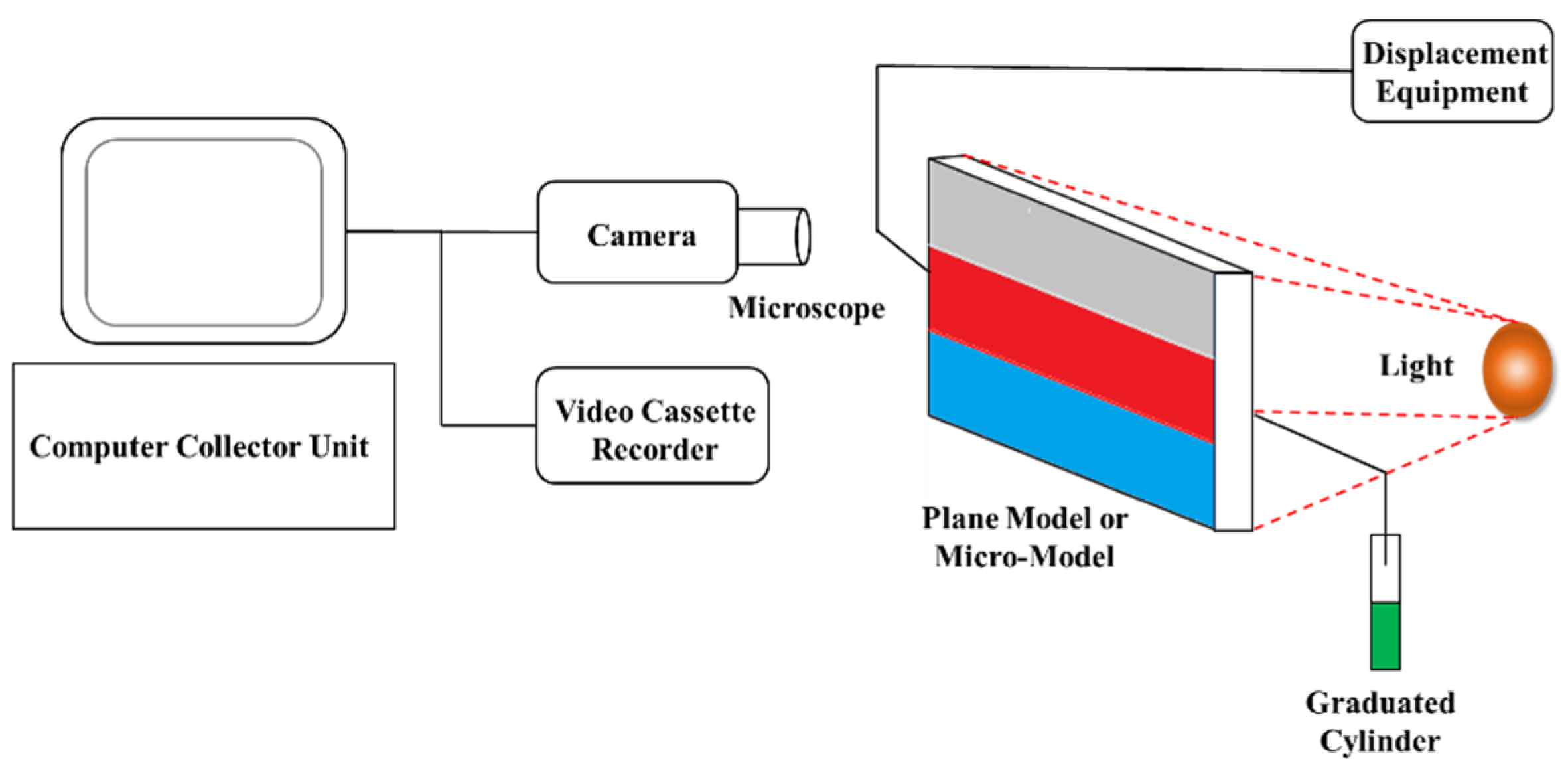
| Type | d0, μm | dmax, μm | B = (dmax − d0)/d0 |
|---|---|---|---|
| SMG-μm | 3.2 | 28.6 | 7.9 |
| SMG-mm− | 16.6 | 68.3 | 3.1 |
| Permeability/(mD) | Matching Coefficient | FR | FRR | Plugging Rate |
|---|---|---|---|---|
| 100 | 1.69 | 10.2 | 6.4 | 90.2 |
| 250 | 1.40 | 9.0 | 7.2 | 88.9 |
| 500 | 1.23 | 9.6 | 9.1 | 89.6 |
| 1000 | 0.98 | 10.7 | 12.9 | 90.6 |
| 1500 | 0.83 | 9.4 | 9.7 | 89.4 |
| 2000 | 0.65 | 6.5 | 5.7 | 85.1 |
| 2500 | 0.55 | 4.3 | 4.9 | 76.7 |
| Permeability/(mD) | Matching Coefficient | FR | FRR | Plugging Rate |
|---|---|---|---|---|
| 250 | 2.67 | 19.9 | 15.3 | 95.1 |
| 500 | 2.07 | 17.2 | 11.9 | 94.2 |
| 1000 | 1.67 | 16.1 | 13.2 | 93.8 |
| 1500 | 1.55 | 15.5 | 14.7 | 93.6 |
| 2000 | 1.32 | 12.9 | 13.5 | 92.3 |
| 2500 | 1.17 | 10.4 | 8.9 | 90.4 |
| 3000 | 0.88 | 8.9 | 7.5 | 88.8 |
| 4000 | 0.75 | 4.7 | 5.8 | 78.9 |
| Core Number | Length/cm | Diameter/cm | Porosity/% | Permeability/mD |
|---|---|---|---|---|
| 2-1 | 10.05 | 2.51 | 18.5 | 100 |
| 2-2 | 10.03 | 2.50 | 20.1 | 250 |
| 2-3 | 10.05 | 2.52 | 22.0 | 500 |
| 2-4 | 10.01 | 2.51 | 24.8 | 1000 |
| 2-5 | 10.02 | 2.50 | 25.8 | 1500 |
| 2-6 | 10.03 | 2.51 | 26.6 | 2000 |
| 2-7 | 10.02 | 2.50 | 29.1 | 2500 |
| 3-1 | 10.04 | 2.53 | 22.2 | 250 |
| 3-2 | 10.02 | 2.53 | 23.8 | 500 |
| 3-3 | 10.03 | 2.50 | 24.8 | 1000 |
| 3-4 | 10.02 | 2.51 | 26.8 | 1500 |
| 3-5 | 10.05 | 2.52 | 27.4 | 2000 |
| 3-6 | 10.06 | 2.53 | 27.9 | 2500 |
| 3-7 | 10.08 | 2.51 | 29.5 | 3000 |
| 3-8 | 10.10 | 2.51 | 32.9 | 4000 |
| Ionic Composition | Na+, K+ | Ca2+ | Mg2+ | CO32− | HCO3− | SO42− | Cl− | TDS |
|---|---|---|---|---|---|---|---|---|
| Concentration, mg/L | 3091.96 | 276.17 | 158.68 | 14.21 | 311.48 | 85.29 | 5436.34 | 9374.13 |
Disclaimer/Publisher’s Note: The statements, opinions and data contained in all publications are solely those of the individual author(s) and contributor(s) and not of MDPI and/or the editor(s). MDPI and/or the editor(s) disclaim responsibility for any injury to people or property resulting from any ideas, methods, instructions or products referred to in the content. |
© 2023 by the authors. Licensee MDPI, Basel, Switzerland. This article is an open access article distributed under the terms and conditions of the Creative Commons Attribution (CC BY) license (https://creativecommons.org/licenses/by/4.0/).
Share and Cite
Ye, Y.; Liu, Y.; Guan, B.; Yang, Z.; He, L.; Xiao, P.; Wang, X.; Li, S. Study on Micro-Displacement Mechanism and Reservoir Compatibility of Soft Dispersed Microgel. Gels 2023, 9, 177. https://doi.org/10.3390/gels9030177
Ye Y, Liu Y, Guan B, Yang Z, He L, Xiao P, Wang X, Li S. Study on Micro-Displacement Mechanism and Reservoir Compatibility of Soft Dispersed Microgel. Gels. 2023; 9(3):177. https://doi.org/10.3390/gels9030177
Chicago/Turabian StyleYe, Yinzhu, Yang Liu, Baoshan Guan, Zhe Yang, Lipeng He, Peiwen Xiao, Xiaocong Wang, and Shichao Li. 2023. "Study on Micro-Displacement Mechanism and Reservoir Compatibility of Soft Dispersed Microgel" Gels 9, no. 3: 177. https://doi.org/10.3390/gels9030177
APA StyleYe, Y., Liu, Y., Guan, B., Yang, Z., He, L., Xiao, P., Wang, X., & Li, S. (2023). Study on Micro-Displacement Mechanism and Reservoir Compatibility of Soft Dispersed Microgel. Gels, 9(3), 177. https://doi.org/10.3390/gels9030177





